“There are no lights in the town, but you are not scared”, Mikiyas tried to reassure me. “Meeting a hyena is a spiritual ceremony, and people believe in spiritual things. In the darkness, you only see two shiny eyes, same like cats.”
After lions, hyenas are Africa’s second-largest predators. And they are certainly not cats. Their shimmering eyes in the dark alleys of Harar in eastern Ethiopia could be compared to Christmas tree lights too. But it would still not make Santa Claus exiting the chimney mistake them for pets.
Contrary to popular belief, which made me misjudge its readiness to attack, the spotted hyena is not a scavenger, but a predator. It will not say ‘no’ to the free meal in the form of a dead animal. But this wild beast hunts for food too.
Outside of the high protective walls of Harar, next to a dusty road with no public lighting, I crouched on a piece of old cloth, turning my back to two dozen eyes twinkling in the dark
With a speed of 60 km/h in their legs and a force of 80 kg/cm2 in their bone-crushing jaws, hyenas are successful killers. They can take down zebras, gnus, giraffes, rhinos, and (why not?) humans.
Yet, here I was, handing all my trust over to Mikiyas Belachwe, a young Ethiopian who presented himself with a business card of a Skinny Boy. I readily accepted the far-fetched idea that I was about to experience a spiritual ceremony.
Outside of the high protective walls of Harar, next to a dusty road with no public lighting, I crouched on a piece of old cloth, turning my back to two dozen eyes twinkling in the dark.
Harar hyenas were just a meter away! According to mathematics, it would take them 60 milliseconds to get me. That’s literally two times quicker than a blink of an eye!
“Don’t blink! Don’t blink!”, an inner voice instructed in my head. And then it snapped, just before me, one of the strongest bites in the animal kingdom.
In case you were wondering, humans are not cats either. We do not have nine lives, and that’s why we should live the one we have to the fullest!
Urban hyenas on the move
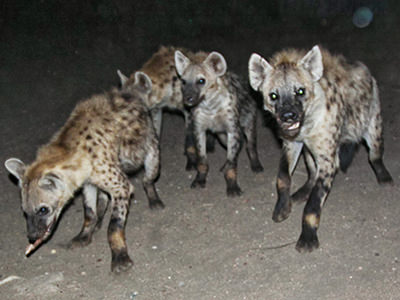
The spotted hyena (Crocuta crocuta) still roamed Europe and Asia in the last glacial period. For the last 12 millennia its only home is sub-Saharan Africa.
Its extinction from the Old Continent was largely influenced by the loss of grassland. This left space for species that adapted better to the forest – wolves and humans.
The spreading of humans and their activities in Africa again threatened spotted hyenas’ natural habitats. The animals started looking for new homes. Surprisingly, instead of retreating, hyenas hit back, which is in line with the concept of retaliation that sometimes shapes their behavior.
In the last decades, they approached even the densely populated cities such as the Ethiopian capital Addis Ababa.
Exchanging wildebeests for stray dogs and cats, hyenas adapted their diet. Even people were on the menu, especially the homeless who slept outdoors at night.
In the search for a midnight snack, hyenas allegedly even broke into the Kechenie Medhanealem Orthodox Cemetery, feasting on corpses in shallow graves.
There is a town in Thailand that feeds its wild monkeys. Read about the Lopburi Monkey Festival banquet!
Hyenas in Ethiopia – the last laugh on the history of humankind
Hyenas’ eating habits directly affected how much we know of our own history. Their powerful jaws and strong stomach acids dissolve even bones, not leaving much room for DNA analysis.
While I stood at the National Museum of Ethiopia in Addis and observed human fossils displayed in the vitrines, I became aware of an unusual paradox. Lucy, Selam and Ardi were indeed dead, but on the other hand, they were also – survivors.
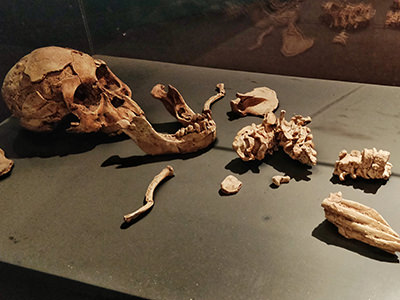
In 2009, Ardi (short for Ardipithecus ramidus), discovered in the village of Aramis, was confirmed as the oldest found skeleton of human ancestors. It dated back to 4,4 million years ago.
Trampled down by hippos, covered by mud and volcanic ash, this 120-centimeter tall female escaped the typical hyenas’ feast.
The pack would normally pull the victim apart, scatter bones everywhere around, and digest every last bit. Hyenas’ feces is white from calcium! Clearly, they are not the best friends of archeologists.
The Awash River Valley is the cradle of humanity. When I joined Mr. Genana from Doho Lodge in the morning search for hyenas in wild, we were looking for an evasive serial killer that leaves disappearing footprints.
Hyenas in Ethiopia move in shadows, and they did not reveal themselves on that morning hike. We could only hear the characteristic laughter that froze the blood of antelopes grazing in the heart of East Africa’s Great Rift Valley, where the continent was splitting apart.
While hyenas mainly appear in front of their victims, there is a public secret that in the east of Ethiopia, beyond Afar, and on the edge of Oromia, the area formerly known as Region 13 could bring us more luck. Its name was Harari, the smallest regional state of Ethiopia.
From Addis to Harar, the Mecca of chat
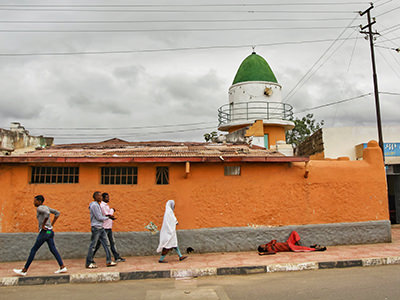
The bus from Addis to Harar, Harari capital, took ten hours. We had three stopovers with uniformed officials thoroughly searching male passengers. While this was still during the 2018 state of emergency, 2020 events in Tigray exposed ethnic conflicts as continuing boiling pot in the Horn of Africa. Traveling in Ethiopia, like hyenas, should be always approached with caution.
The area of Harar is the first place Muslims migrated to from the Arabian Peninsula, in the 7th century. The followers of the Prophet Muhammad found sanctuary from persecution in what was then the Kingdom of Aksum, the second officially Christian world state!
After Africa’s Mecca became the city of Harar in 1007, religious tensions started destabilizing the region. Five centuries later, Emir Nur ibn Mujahid finished the fortification of the city with thick protection: five-meter-high walls!
Only Muslims were allowed to enter the town with 100 mosques. The first European who broke into the forbidden city was the British explorer Sir Richard Burton, disguised as a Turkish merchant.
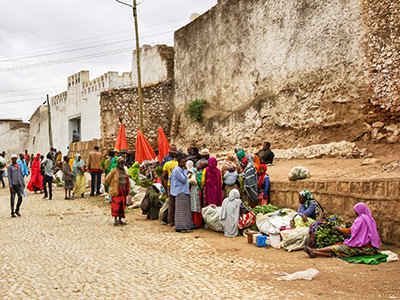
Burton discovered Harar was growing and consuming an addictive native plant called chat, or khat (Catha edulis). The same as with coca leaves in South America, he found out that chewing chat stimulated excitement and euphoria.
Seeing Harar through the dusty windows of the bus left no doubt that we were entering a city of a peculiar social profile.
With bundles of the green plant under their arms, the locals were engaging in chat chewing ceremonies. Some were uplifted to the level of physical confrontation. Some were sauntering naked, disconnected from time and space.
Those who left their high were laying in the middle of the road, covered in blankets and pieces of garbage. At twilight, these drugged people looked like some delicious human injera that hyenas would die for.
Waste management and pollution are serious problems in Ethiopia. Read more about how the travel industry can fight for a plastic-free world!
Street food for hyenas of Harar
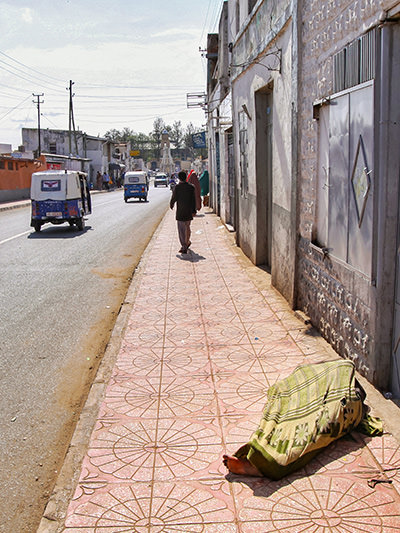
A young man I shared the bus seat with, was rushing to continue the journey to his hometown of Jijiga, near the Somalia border.
Only later I would find out that Jijiga goes quiet after dark, with outdoor sleeping equaling suicide.
A Somali woman told the researcher Marcus Baynes-Rock in 2011: “Hyenas are harmful in Jijiga. They will eat humans and animals. They go out at 6 pm and then nobody will be out after that time.”
Just a hundred kilometers apart, Harar did not look like a city that prepared for any kind of nighttime danger.
And juicy human toes protruding under a blanket were certainly not the only invitation for all-you-can-eat Harar’s street food scene.
I’ve seen a livestock fair, a street with parked donkeys, and goats laying on the warm cobbled ground, with young ones jauntily romping head-to-head.
Small children were playing unattended until dusk.
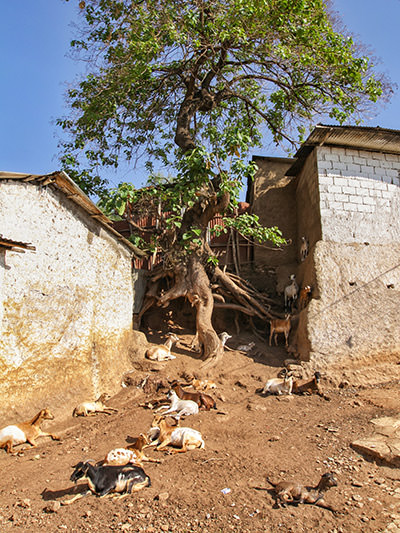
Nothing was warning that any menace would be lurking in the labyrinth of 368 narrow alleys of Jugol, the old walled city of Harar.
The high walls of compounds were painted in a variety of pastel colors, portraying a likable place.
Nevertheless, I rented a room outside of the city walls, at a cheap guesthouse that probably doesn’t deserve a mention.
Some travelers were complaining about the bed bugs, but the property was looking right at the football field where hyenas supposedly came to eat the leftovers and rest.
The unfriendly barking dogs deterred me from exploring the human-like giggles in that unlit place. But at the time of booking, the hotel that enabled easy access to hyenas at night seemed a pragmatic idea.
Also, there were no bed bugs. For the record, I did find a giant cockroach and one bigger beetle that could have been someone’s pet on the loose.
Harar gates – for humans and hyenas

The fourth holy city of Islam is not what it used to be in the times of Richard Burton. Today, Harar gates readily open to foreigners.
As soon as I exited the bus, locals welcomed me with offers, following my every step. Some even proposed a “free tour” of the town.
With the help of my Jijiga travel companion, I managed to turn away all that unwanted attention tourists often face in Ethiopia.
But one young man eventually broke my suspicious armor. He charmed me already with his nickname.
“I’m the skinniest boy in Harar”, proudly said Mikiyas, pulling out a business card with the imprinted name of – Skinny Boy.
I politely explained that I wasn’t looking for a guiding service, but in the end, agreed to hang out as friends. Nevertheless, this aspiring 24-year-old tour guide did not nig on information on his hometown.
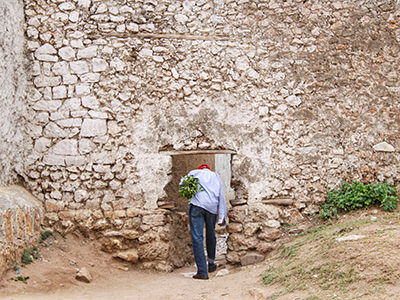
As it turned out, the city that decided to defend itself from hostile Oromo neighbors with a 3,5-kilometer-long wall, also chose to break the holes in it, so that hyenas could easily get in.
“Our king has made five big human gates and small hyena gates”, Skinny Boy explained. “If you walk the narrow streets, you will see a lot of garbage in bowls. People throw this garbage in front of their houses during the day. When the night falls, hyenas get inside the wall through their gates and they pick what they want. We use hyena like a servant or a waiter, not like a wild animal!”
The fact that the city that was securely locking its gates at any hint of threat, and evicting non-Hararis after dusk, exposed itself to free-roaming of Africa’s most terrifying wild animal is quite fascinating. Hyena doors seemed to open up to a very complex relationship between humans and these often misunderstood animals.
Preying on Harar’s butcheries
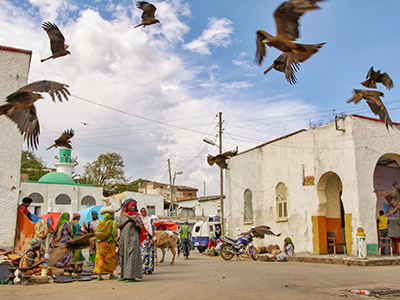
Spotted hyenas live in clans. The hyena communities closest to Jugol are the Sofi clan (east of the city) and the Aboker clan (north of the city walls).
For centuries, these feral warriors were passing hyena gates, fighting for Harar territory. The strategic target of clan wars was always Gidir Magala, the main town market. This is where Halal butchers were selling meat in two U-shaped buildings framing the square.
The best view of the crucifix-resembling space was reserved for wild animals eyeing from the edge of the buildings, in a low start. Black kites, unlike hyenas, were not waiting for the night to claim the leftovers.
The gallery of birds of prey painted an ominous atmosphere. Only Muslim women rapidly passing-by in bright clothes gave a dash of color to this gray square where everyone walked with caution.
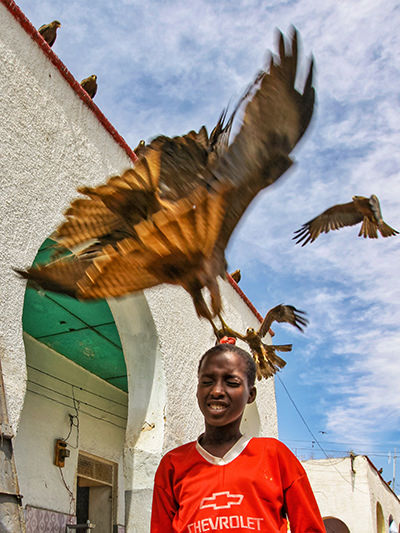
One enters the shop, waits for the butcher to chop the meat, and then quickly, with no unnecessary delays, leaves the market, firmly holding the purchase hidden under the layers of the dress.
Kites were crashing from the skies without warning, at any glimpse of meat they could grab. A girl from one of the butcher shops never got used to it. When the flock of kites glided down towards some disposed pieces of meat, she released a dramatic scream.
Encounter with Harar kites requires bravery. Abas (13) came out of the butchery with a fistful of meat morsels hidden under his shirt, eager to pass the test of masculinity.
First, he would just toss the scraps in the air, seeing kites swooping from the rooflines, like flying acrobats. But as the courage grew, Abas would offer meat directly from his hand or even by proposing it on the top of his head. Kites would fly over and pick it up with immaculate precision.
Harar hyena feeding – taming the wild
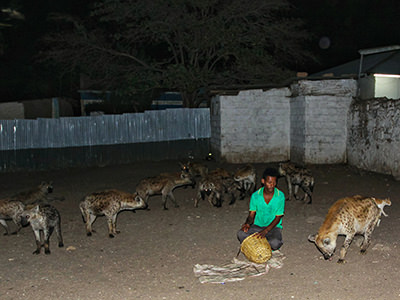
Harar obviously cherished a special relationship with its wildlife, one we could hardly find elsewhere.
Just when I asked myself whether feeding wild birds of prey at Gidir Magala could be considered an audition for the infamous Harar hyena feeding, a downpour washed my thoughts away.
Standing under the eaves of the Tailor Alley, a street filled with the hypnotic sound of Singer sewing machines, I started doubting that hyena men would show up at an informal town’s night spectacle – feeding hyenas by hand.
Skinny Boy claimed that some rain would not stop the century-old tradition. A tradition that actually started in a time when rain was scarce.

“At the end of the 19th century, we had a big drought and poverty in Harar”, Mikiyas the Skinny Boy explained. “Hyenas, but also some other wild animals, started attacking people. And people started to be scared. Our king said: ‘When you see the animals, just throw them any waste of food you have!’ And when people saw hyenas, they threw the meat. With time, they became more domestic. In Harar, the hyena is even more domestic than a dog!”
But is there really a – domesticated hyena? It is one thing letting them recycle the organic waste we leave outdoors. But feeding wild hyenas with scraps of meat by hand surely puts us at the mercy of these animals, one they don’t show in other parts of Ethiopia.
Getting close to animals whose bite is almost two times more powerful than the one of a lion, and can easily crush a bone of an elephant, requires some good luck. Even if we believed that the behavior of hyenas of Harar changed, they could still make mistakes. At least once, hyena bit the hand of its feeder, and dragged him several meters, mistaking human flesh for offered meat.
Hyena whisperers in action
Catering for two hyena clans, Harar also has two hyena feeding sites, clearly marked on Google maps. Both of them are located outside of the fortified historic town enlisted as UNESCO World Heritage in 2006.
The original Islamic hyena feeding site is 450 meters south of Erer Gate (or Argoba Gate). This is the place where the regular feeding ritual started in the 1950s, by a man called Dozo. It ended up as a project of the Yusuf family. Mume Salleh did it until 2004 when his son Abbas continued his work.
The second Harar hyena feeding site exists since the beginning of this century. It is located next to a Christian-owned slaughterhouse, 400 meters north of the Fallana Gate. Biniam Ashenafi inherited the business from his brother and already started preparing younger successors.
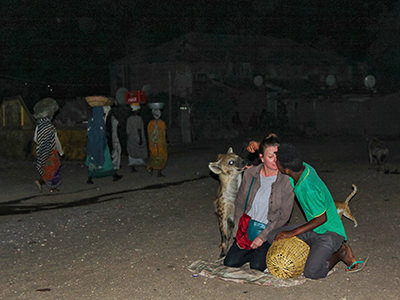
We met Biniam just before twilight, at the rocky outcrop overlooking the valley. This 32-year-old had a wife and three kids at home, but every night he spent time with hyenas, his “second children”. Biniam seemed quite relaxed when he started the dinner call, stimulating himself by chewing the famous appetizer – the chat.
“So he can have the needed energy!”, Skinny Boy whispered into my ear.
Summoning children at a dinner table might already be a feat in itself. I imagined hyenas had to be more complicated beings.
For at least half an hour, Biniam’s screaming voice traveled over the farmlands, inviting hyenas to exit their dens. Grinding the Abyssinian Tea between his teeth, he was addressing each hyena by its name!
It was a melodic call in “hyena dialect”, his voice cracking during this animalistic ritual, breaking the silent end of the day, and sending shivers down my spine.
It sounded beautiful, but also somewhat intimidating. The darkness was swallowing the valley.
In Kenya, the caretaker of the northern white rhinos, the last two remaining in the world, communicates with them through whispers. See the fantastic photographs made by Matjaž Krivic!
The town that feeds hyenas has no fear
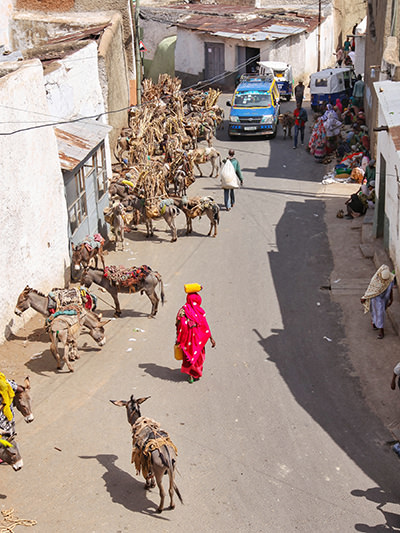
The other villagers in the vicinity of the slaughterhouse did not fear the unknown. They were calmly finishing their work on the land. Goats were still walking down the road carefree. Children did not rush to finish their playtime.
Since the earliest age, Harari children learn about waraba (local word for hyena) as a huge monster that patrols the roads looking for children to eat. However, these kids here seemed not to be concerned at all with the fact that hyena call would soon bring dozens of warabas to their neighborhood.
“Do you hear the dogs barking? That’s it! When they come, the dogs make the sound”, the Skinny Boy explained.
It took some time for the pack to gather. The noise of bajaj vehicles passing by and villagers continuing with their daily routines slowed them down.
But eventually, one by one, silent predators timidly appeared on the dirt road in front of the slaughterhouse. After an hour, there were ten of them at least.
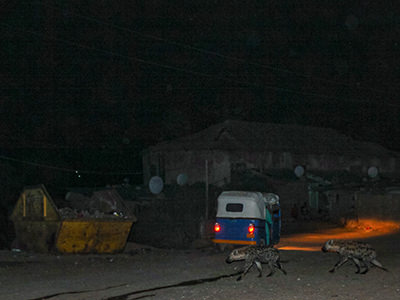
Hyena men were throwing pieces of meat on the ground. At each throw, a quick shadow appeared out of nowhere, grabbed the treat, and ran back to the thick cover of the night.
Some were lazily curling up, knowing that once the real show begins, more beef scraps would be flying through the air.
When some photo-motivated tourists appeared in a vehicle throwing stripes of light over the scene, we could see that hyenas were not alone.
Tiny kittens and even one friendly dog were hoping to get their part of the dinner too. The best way to destroy the drama of the photograph is to include a labrador waving his tail. With careless cat casually sitting and mewing in the middle of the hyena pack, the image of a dangerous beast dissipated completely.
Hyenas fed by hand and – mouth!
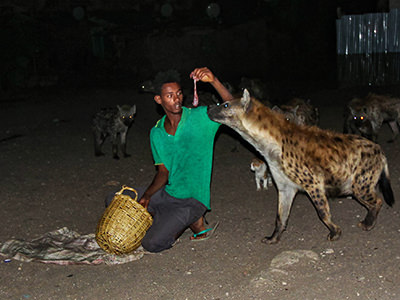
One of the hyena men brought a wicker basket filled with meat scraps and started the feeding.
The largest hyena, a matriarch, had a privileged position in this ritual. Subordinated hyenas were playing hide-and-seek game, waiting for their chance with respect. Cats also knew that hyena is always quicker.
The hyena man was wearing flip flops, not the footwear we would expect at probably one of the most dangerous jobs in town.
There was no music. The spectacle was as raw as the meat scraps wagged in front of the hyenas.
To some, he was offering the meat with bare hands, as if he was approaching a friendly dog.
Sometimes he would skewer a piece of meat on a stick, put one end in his mouth, and wait for the hyena to self-service.
In another version, he would hold the chunk of meat high in the air, and the hyena would step on the spectator’s back with front legs, and grab the prize.
This is how the unavoidable performance at every list of things to do in Harar looked like.
My participation in the hyena feeding ritual
When offered to volunteer in the hyena feeding ritual, I didn’t think much. As mentioned before, I was convinced spotted hyenas were scavengers like striped hyenas. I perceived a much lower level of danger because – I was not dead. Also, the presence of cuddly kittens was quite reassuring.
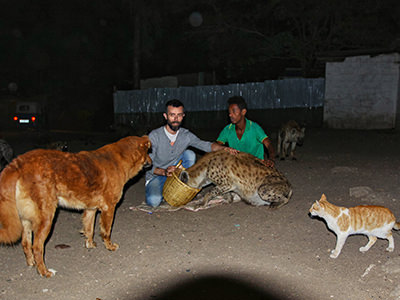
The experience filled me with laughter, and certainly not because of fear. People were photographing me, but with all these other tiny pets walking around, I was aware this was not even pretending to be an act of courage.
Biniam testified that tourists sometimes trembled and even fainted during his acts, but I couldn’t stop laughing at the subtle absurdity of the scene. I was facing the scary carnivore, and a little kitten was mewing a meter away. How could I keep my face serious?
Still, I have to admit, when the hyena man held a piece of meat close to my ear, and the hyena’s jaws quickly tore it away, I will never forget the extreme sound of that bite! If it would have been my ear between those sharp teeth, I think I would have died of shock, not bleeding. That sound quickly belittled any idea of masculine heroism.
At the end of the day, I could brag that hyenas were taking food from my mouth and that I even petted one’s back when she dived head-first into the basket.
But this one-of-a-kind close-up encounter with an animal capable of digesting the largest bones left me with more questions than answers.
“Hyenas have seven horsepower, but they don’t use this power to attack”, Skinny Boy tried to explain. “They are animals, the same as a human. If you kick me, I kick you too. That’s why we have respect! We don’t touch them, we feed them. And then we are not scared.”
What if Harar hyenas are not – hyenas?
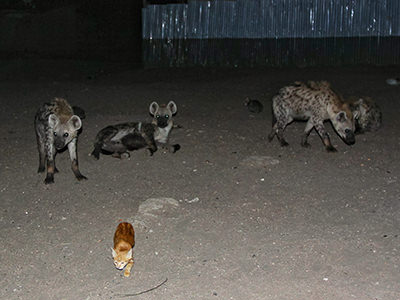
Living with hyenas instead of living with the fear of hyenas brings numerous benefits to Harar. Hyenas clean the town of waste. They eat provided food instead of eating children and homeless people. Being territorial animals, they keep other hyena groups away, and those would probably not follow Harar’s unwritten constitution of peaceful co-existence.
The non-aggression pact between people and hyenas was arranged long ago. It reinterpreted the history of Harar, but also the local hyena mythology.
As Biniam, the hyena man, says: “We don’t call them hyenas. We call them young priests.”
Indeed, the Harari word waraba is derived from werabba which means a ‘newsman’. In local mythology, the town saints discuss town matters every Thursday and then send their conclusions via hyenas, the messengers. People who can interpret their howls are hyena listeners or translators.
One city in Japan sees deer as messengers of gods. Meet Nara, the capital of deer!
While the rest of Africa often associates hyenas with witchcraft, hyenas of Harar have a sacred mission of communicating with saints.
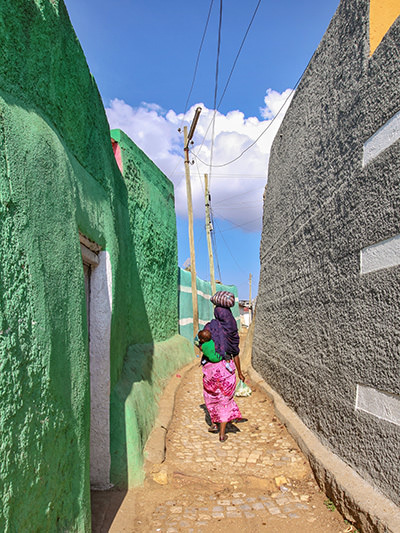
This started in the times of Emir Nur, the builder of the Harar wall. Hyena holes were allegedly a part of a truce agreement between the Harar ruler and the leader of the hyenas, the white hyena king.
Hyenas were afraid that the wall would cut their access to food supplies but accepted to stop killing the citizens as long as they build exclusive gates for them.
In return, they did not just eat the town’s waste, but also jinns. Hyenas are the only beings that can see these evil spirits entering the people of Harar (don’t confuse it with chat!).
Hyenas can diagnose the possession, attack the jinn and swallow it, with their characteristic whoop sound as an equivalent of a human burp.
There have been instances of executing exorcisms on possessed individuals, which included the inhalation of smoked hyena feces.
Feeding wild hyenas at Ashura – urban legend or true mystery?
The pact between humans and hyenas is renewed every autumn, on the 10th day of Muharram, the first month of the Islamic calendar.
During the ceremony of Ashura, Hararis prepare a special porridge from various types of grain mixed with plenty of butter and offer it to hyenas at shrines outside the town.
If hyenas, led by the white hyena king, do not touch the meal at all or eat it completely, they predict the return of famine and drought. If they leave some of the porridge in the bowl, the year ahead will be good.
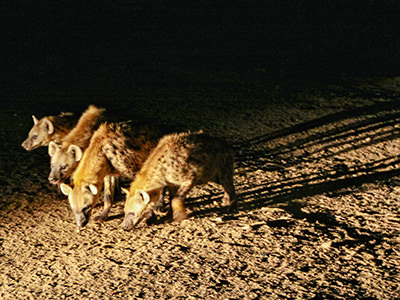
This Ashura ceremony, which is not in sync with the Quran’s directive that searching for secrets of the future is actually a sin, became a sort of an urban legend. Hyena as a messenger started to become the missing link, just a story.
Many Hararis talked about the hyena porridge ceremony as a fact, but most of them never participated in any. There was no photographic or video proof of the event. Even the Bureau of Culture in Harar tried to film it for fourteen years, with no success.
But in 2009, Marcus Baynes-Rock managed to witness and film the event at Aw Nugus shrine, 28 kilometers north of Harar. He described in his PhD thesis on social relations with hyenas that the hyena appeared five minutes after people offered the porridge!
When you think about the context that this happened miles away from urban hyenas of Jugol, in the area where hyenas are truly wild, and not fed on a daily basis, the appearance of a prophet hyena at the feast sounds quite extraordinary.
Witnesses were only surprised and disappointed by the fact that the hyena that first ate the porridge was not – white.
Video from the 2009 event is not online, but I found Ashura 2019 footage that adequately illustrates the event. No sound, but you’ll get the picture!
Spotted hyenas in Harar, an exceptional exception
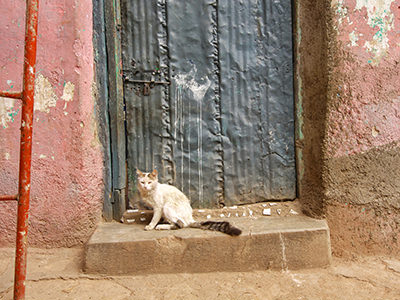
Seeing Harar hyenas in a domesticated setting, eating porridge and standing next to typical pets like cats and dogs, raises a valid question: Are hyenas dangerous? Is Harar actually training a new breed, pet hyenas in Africa?
Science tells us hyenas are definitely predators to behold. Strong and fierce, they show no mercy to their food with legs.
But for 100 Birs, in Harar, a hilltop town 500 kilometers from Addis Ababa, one can survive the close-up encounter with a giant hyena equipped with a strong body, long neck, and massive skull. Those eyes glowing in the dark suddenly become the eyes of a being that only tries to survive, and is capable to adapt.
They have been here for centuries and practically obtained Harar citizenship. They became the members of the family in the town whose emirs wanted to affirm it as a place of peace.
While other Ethiopian towns live in fear of the human-eating animal, hyenas of Harar are treated as equal and have not killed anyone in 200 years
Maybe hyenas didn’t make it to the town’s flag, but – a dove did! Even UNESCO recognized Harar’s effort in making peace between nations. Hyena nation, of course, still needs to appoint its UN diplomats!
Hyenas’ negative reputation, especially in the intelligence department, perpetuated by popular culture (Disney did receive protests, boycotts, and even a lawsuit for defamation of hyena as a villain in “The Lion King”), is contrasted by their peculiar social rules and even administration of justice. These mystic animals reconfirm themselves as species that remember, punish their own offenders, and even pay favors.
While other towns fear of hyenas’ terror and their attacks on humans, the Ethiopian hyena capital approached these nocturnal creatures as equals and negotiated the system that worked for both sides.
With supposedly no fatal incidents in Harar in the last two centuries, the laughing hyenas might be much smarter than what we give them credit for.
He who laughs last, laughs longest.
If you are considering feeding hyenas yourself, and are wondering where to stay in Harar, you will find the online accommodation offer quite scarce. But here's where you can look for hotels that offer online booking in Harar! Also, if you want to experience more wildlife during your stay, make sure to check the Ethiopian wildlife lodges!
Did you like this article on Harar hyenas?
Pin it for later!
Disclosure: This post may contain affiliate links, which means if you click on them and make a purchase, Pipeaway might make a small commission, at no additional cost to you. Thank you for supporting our work!

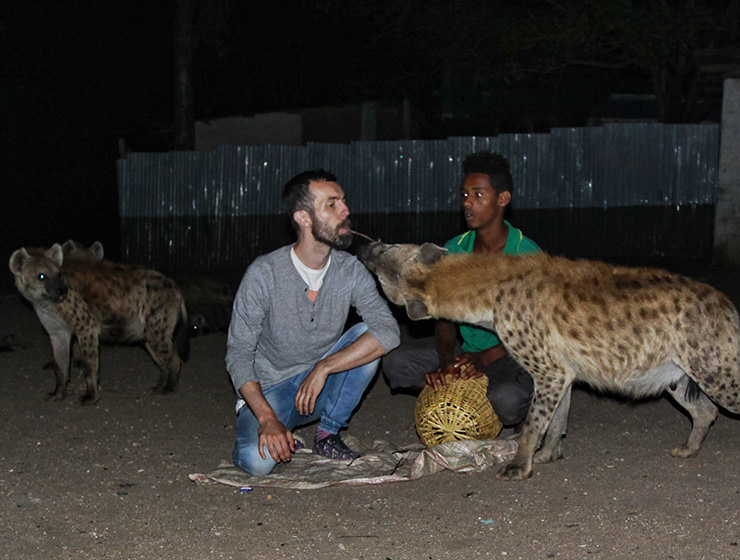
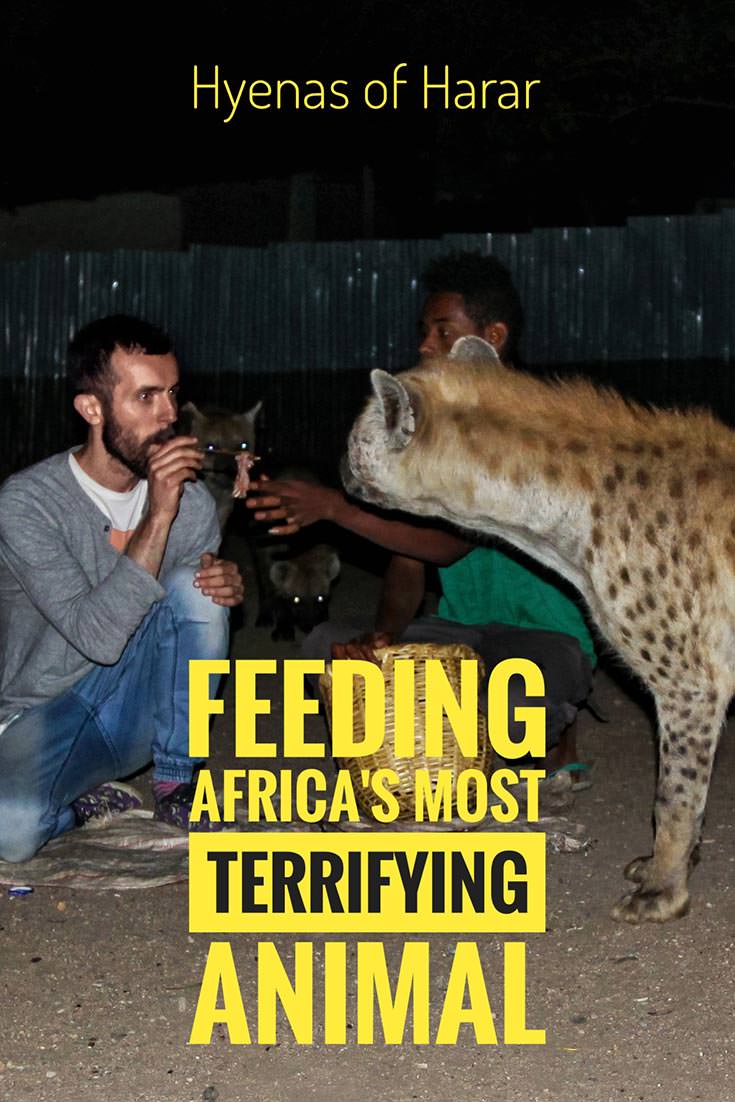
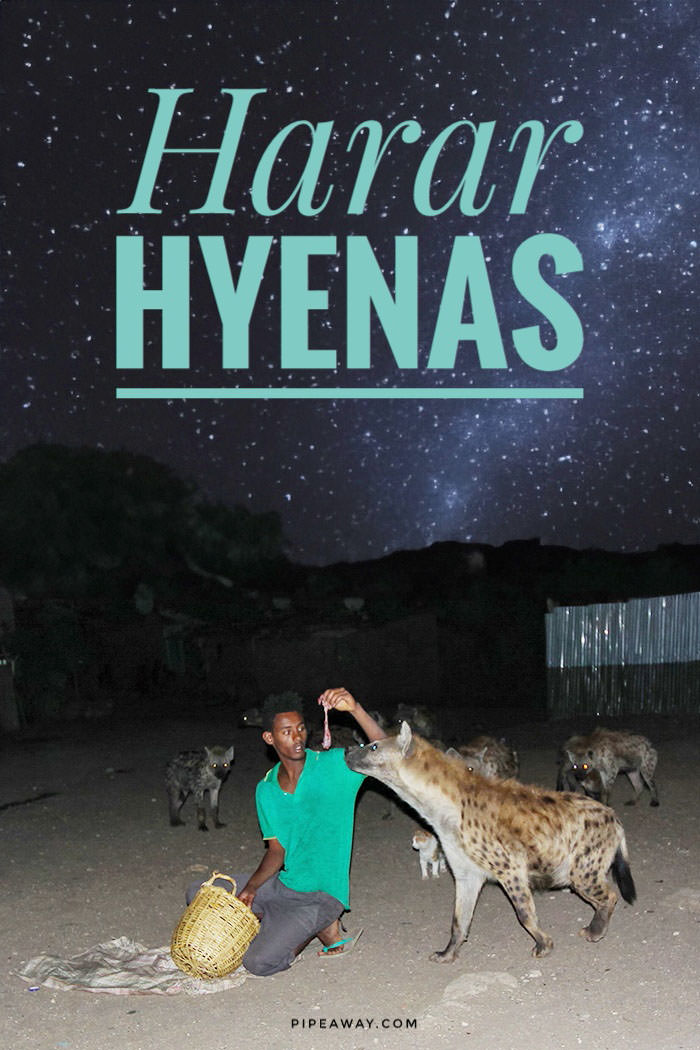

I would not have thought it possible to feed hyenas like this. Thanks for the interesting story!
Thanks for your comment, Darla!
Yes, it seems that the lesson about not eating the hand that feeds you works quite literally in Harar.
Incredible place!
this animal is going to extinct, here in Africa they all time hunt hyena. and there is no law to save it from hunters or farmers :/ and even some people try to keep it .
I understand your concern about this special animal.
It seems the Harar recipe works. We can only hope that hyenas can thrive in other parts of Africa too, without danger for people or their livestock.